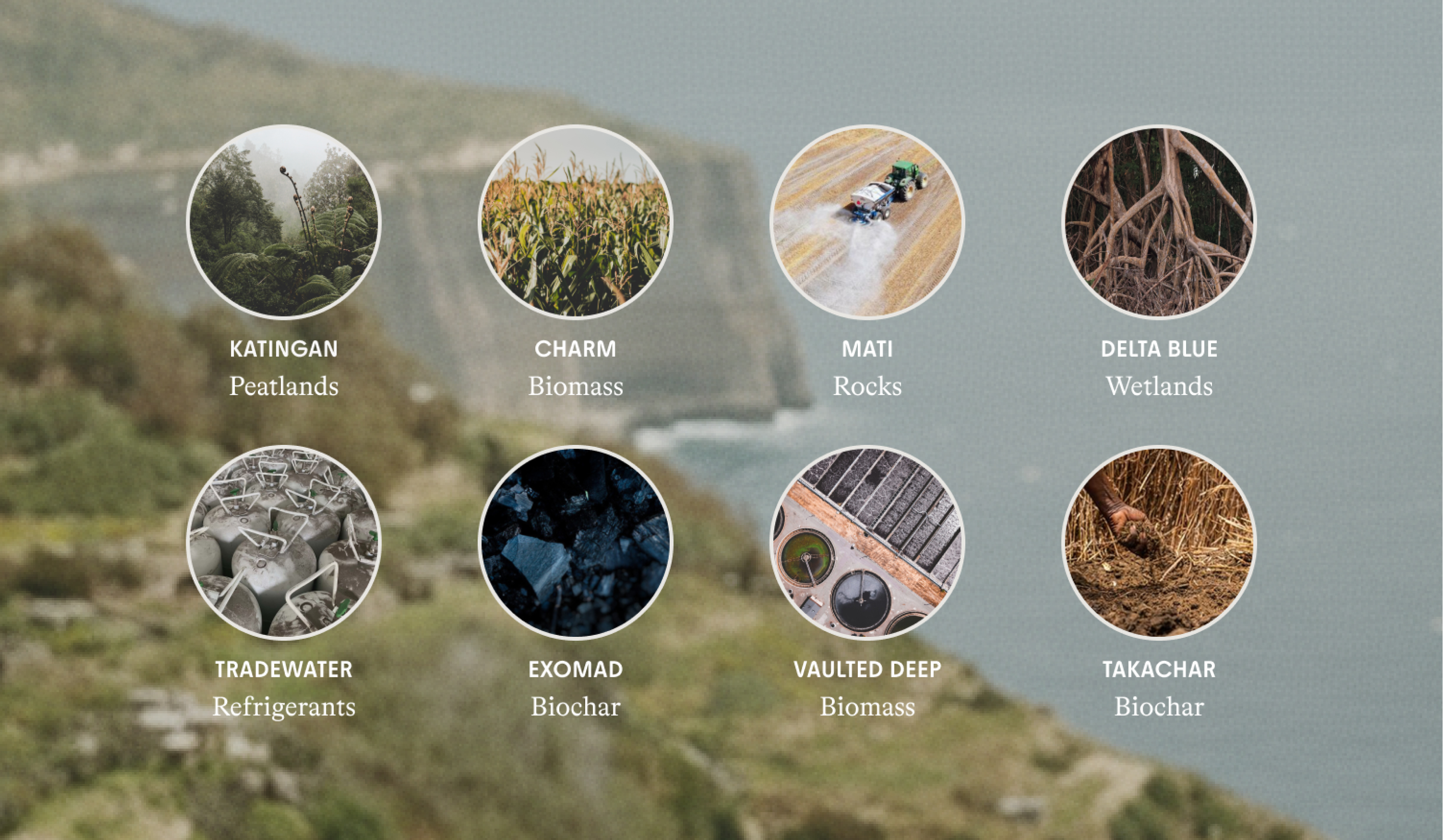Tax-deductible Offsetting Portfolios

Join the community





Last updated on Nov 25, 2025.
It’s possible to avoid the worst effects of the climate crisis if we act quickly to reach net zero emissions by 2050. However, no single climate solution will be enough to get us there.
Over the next 25 years, investments in climate solutions must balance those that avoid, reduce, or remove carbon now with longer-term, earlier-stage solutions that remove and store carbon permanently. For now, those solutions are more expensive as they demonstrate success and scale.
Throughout the year, our carbon experts evaluate new climate solutions to ensure our community is supporting only the best on the market. Not all offsets are created equal, and our team prioritizes those with proven, measurable climate impact and that benefit communities and ecosystems.
A Portfolio-Based Approach
According to the Oxford Principles for Net Zero Aligned Offsetting, a portfolio approach is the best way to balance impermanent, near-term solutions with permanent, long-term solutions. Ultimately, these portfolios will move towards 100% Carbon Dioxide Removal (CDR) with the lowest risk of reversal.
By adopting this approach, earlier stage technologies that permanently remove carbon receive the support they need to scale today, while still taking advantage of the plethora of available solutions with short-lived reduction or removals.
Our three offset portfolios give you multiple ways to support impactful climate solutions, with varying levels of permanent removal. All of them optimize for benefits to the climate and communities, while minimizing risk.
- Balanced ($35/ton): Best-in-class solutions already at scale, with an emphasis on nature-based approaches (3% permanent removals)
- Catalytic ($150/ton): Blended support for at-scale and emerging climate solutions (30% permanent removals)
- Pioneering ($500/ton): Early-stage, innovative technologies for long-term removal (100% permanent removals)
Commons’ Offset Partners
To date, Commons has evaluated hundreds of potential carbon offset projects, with few passing our bar for quality. When we support a project, we aggregate our community’s purchasing power to ensure you receive the highest impact for your dollars.
Our partners protect and restore forests, capture and destroy potent greenhouse gases, and even sequester carbon-rich bio-oils deep underground.
Nature-based Projects
Trees store carbon as they grow – one of nature’s natural carbon removal storage technologies. Recent research shows global forests store about 30% of all annual human CO₂ emissions. Forest restoration and protection could store up to 122 gigatons more carbon by 2050.
The Commons community supports the Katingan Peatlands project, which protects and restores tropical peatlands while supporting communities and ecosystems.
Marine and coastal ecosystems can store up to five times more carbon (referred to as “blue carbon”) than land-based forests, making them especially essential to protect and restore. Coastal wetland protection and restoration efforts can store up to 2.6 gigatons more carbon by 2050.
The Commons community supports Delta Blue Carbon, which restores and protects 350,000 hectares of degraded mangroves and coastal wetlands in Pakistan.
Refrigerant Destruction
Fluorinated gases, historically used as refrigerants, have a global warming impact of up to 9,000 times greater than carbon dioxide. Beyond contributing to global warming, refrigerants also harm our planet’s ozone layer, a vital shield against harmful Ultraviolet (UV) radiation for Earth’s ecosystems.
Safely collecting and destroying these gases prevents their release into the atmosphere, avoiding these harmful impacts. Refrigerant management efforts can prevent up to 57 gigatons of carbon emissions by 2050.
The Commons community supports Tradewater, which collects and destroys the world's most potent greenhouse gases.
Biochar Carbon Removal
Biochar is a stable, carbon-rich material created from waste biomass like forestry residues or agricultural waste. Biochar’s high carbon content helps it resist degradation, with sequestration lasting potentially hundreds of years.
Biochar is positioned to scale rapidly because it leverages existing biomass residues, technologies, and farming land. It has significant benefits for farmers and local economies, including reducing pollution and risk of wildfires. It improves soil health, drought resistance, and crop yields, which can further mitigate forest-clearing for agriculture.
The Commons community supports Exomad Green and Takachar, which are both serving critical roles in scaling biochar in the Global South.
Enhanced Rock Weathering
Enhanced Rock Weathering (ERW) is the process of integrating finely crushed rock powder into farming systems, accelerating natural weathering processes that capture CO₂ and storing it for thousands of years. By utilizing existing farmland and abundant mining byproducts, it offers a pathway to rapid, large-scale deployment.
Beyond carbon removal, the rock powder enriches soils with essential nutrients, improving yields and crop quality. Many providers offer it free of cost, helping farmers increase their incomes while building long-term soil health.
The Commons community supports Mati Carbon, which received the $50m XPRIZE in 2025 for its innovative, locally-led approach. Mati focuses on smallholder farmers in India and Africa, who not only are disproportionately impacted by climate change, but also stand to gain the largest improvements in crop yields and income.
Biomass Carbon Removal & Storage
Biomass conversion projects can sequester carbon for 100s to 1000s of years. By pairing the ability of plants to absorb carbon dioxide with engineered technology, biomass projects create durable, carbon-rich materials that are easily stored.
The Commons community supports Charm Industrial and Vaulted Deep:
- Charm transforms brush collected from wildfire prevention efforts, transforms it into a carbon-rich bio-oil, and injects it deep underground to store permanently.
- Vaulted Deep transforms organic waste into a carbon-rich slurry that it injects deep underground. The organic waste that Vaulted Deep uses – manure, treated sewage, paper sludge, and agricultural byproducts – would otherwise decompose, polluting local air, water, and soil with carbon and methane.
Direct Air Capture
Direct Air Capture (DAC) uses engineered systems of fans and chemicals to separate CO₂ from the air, and store it permanently deep underground. The emissions removal capacity for Direct Air Capture is functionally unlimited, it is measurable and verifiable, and benefits from policy tailwinds.
To date, these technologies have operated at small scale and high cost. The process is energy intensive, so access to cost-effective renewable energy for these projects is crucial. Expertise in – or access to – geological storage is also essential.
Commons’ community support helps these companies reduce these costs over time, while unlocking new options for geological storage. We prioritize projects that will address the most pressing challenges facing Direct Air Capture, and those that deliver benefits to the communities they’re operating in.
Marine Carbon Dioxide Removal
The ocean is the planet’s largest carbon reservoir. Marine Carbon Dioxide Removal (mCDR) accelerates the natural processes by which CO₂ transfers from the atmosphere into ocean- and river-based environments, where it is stored permanently. Beyond carbon removal, some solutions have the potential to restore local ecosystems.
Marine CDR approaches range in maturity – some approaches, like river liming, have been deployed for decades, whereas others, including electrochemical-based approaches, are more nascent.
However, Marine CDR solutions face a slower path to operating credibly and cost-effectively at scale. Responsible, gated deployment is critical in sensitive marine ecosystems, and measuring and verifying carbon removal in marine environments is complex.
Commons prioritizes projects with aligned carbon and ecological benefits, as well as real-time monitoring and response to ecosystem health data. This helps ensure that project activities enhance marine life instead of harming it, delivering on promises to local communities. We also prioritize projects addressing gaps in measurement and verification through research, in order to advance Marine CDR solutions writ large.
Commons' Rigorous Offset Evaluation Process
The offset projects selected by Commons are backed by evidence and analysis. To evaluate projects, our team conducts in-depth research, consults third-party analyses, and engages with experts to ensure they meet our high standards.
First, we screen projects for carbon integrity. In other words, do projects actually reduce or remove the carbon they claim to?
Our Carbon Integrity criteria include:
- Verifiability: The carbon reduction or removal must be measured and rigorously evaluated by a trustworthy, independent third party.
- Enforceability: Credits must be backed by a contract that defines exclusive ownership. The supplier must demonstrate that the carbon credits issued from a project are sold only once.
- Additionality: Projects must provide evidence that the carbon reduction or removal that would have occurred anyways, without the carbon finance.
- Permanence: To stabilize atmospheric concentrations of greenhouse gases, long-term carbon removal and storage is critical. Projects must prove the duration for which carbon was removed or reduced.
- Transparency: We work with partners that operate transparency, and provide specific, clear, well-documented evidence of carbon reduction and removal.
Second, we prioritize projects with transformative potential. These projects deliver meaningful benefits to communities, ecosystems, or carbon markets writ large.
We prioritize projects that are researching, quantifying, and optimizing the benefits for those critical stakeholders. When they’re aligned, we know these projects are more likely to deliver on their carbon impact, too.
Our Transformative Potential criteria include:
- Market Efficiency: Commons favors options that provide a higher percent of overall cost to project owners, to support a more efficient and direct market.
- Scalability: Commons favors scalable projects that can meaningfully contribute to reaching global “Drawdown” by 2050 — when levels of greenhouse gases in the atmosphere stop climbing and start to steadily decline.
- Catalytic Potential: Commons prioritizes projects that advance innovation, demonstrate replicability, and inspire similar future projects.
- Ecosystem Benefits: We support projects that create benefits to natural ecosystems beyond carbon reduction, including conservation, biodiversity, and climate adaptation.
- Community Benefits: The climate crisis presents enormous equity and justice challenges. We prioritize projects that will benefit the poorest and most vulnerable populations who are affected most by changing climates.
You can support the solutions we need most to achieve net zero by 2050.
The Commons Offset Portfolio allows you to buy into a carefully blended selection of climate solutions that align with the Oxford Principles to get our world to net zero emissions by 2050.
Companies at the forefront of carbon removal investments, like Microsoft and Shopify, have used a similar approach to frame their large-scale carbon removal purchases and bought into many of the same projects as Commons. The Commons Offset Portfolio makes this high-impact approach to offsetting available to regular people, by aggregating demand and doing the same kind of in-depth research and monitoring that larger companies do, on behalf of all of us.
Offsets Complement Behavior Change and Accelerate the Transition to a Sustainable Future.
The best way to move to a low-carbon future is to build a society that uses less fossil fuels. It is critical that we prioritize cutting our own emissions wherever we can. Commons help people shift their spending to more sustainable products and services, delivering an important signal that we demand cleaner options.
However, for as long as we live in a fossil-fueled society, there will always be a portion of emissions that we cannot reduce on our own. Supporting high-quality carbon offsets helps build capacity of essential climate solutions. And by funding these solutions, our community can enable emissions reductions and removals beyond what would be possible on our own.













